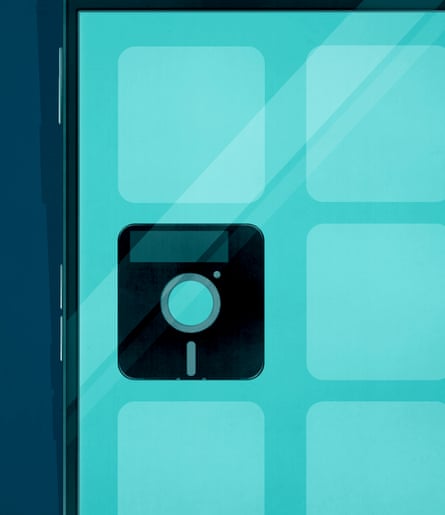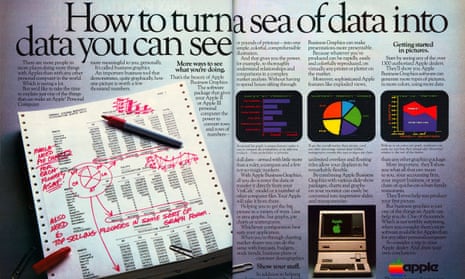Tidying my office the other day, as one does at this time of year, I came upon a shabby, brown, dust-covered, A5 plastic ring binder. It was the kind of thing one throws into a skip without a moment’s hesitation. Except this wasn’t something to throw away, for embossed on the spine of the binder was “VisiCalc”. Inside was a 5.25in floppy disc and a glossy manual. And as I stood there looking at it I had one of those epiphanies that James Joyce was so keen on. I was suddenly transported back to late November 1979. I had bought an Apple II computer on a research grant – the more expensive 32k model, which had an external disk drive. An academic colleague who was on sabbatical at MIT had sent me a postcard saying that he had seen an Apple II running some weird software for business planning that was driving people wild. So I asked him to get me a copy and it arrived via FedEx.
VisiCalc was the world’s first spreadsheet program. It was written by Dan Bricklin and Bob Frankston and came from an insight Bricklin had one day while attending Harvard Business School. A professor was teaching a class on financial modelling, which he did on a blackboard that was ruled with vertical and horizontal lines. He was writing formulae and numbers into the cells of the resulting table. But because many of the numbers in the cells depended on other cells elsewhere in the table, whenever the teacher wanted to change an assumption, all of the ensuing recalculations had to be done by hand. If ever there was a job that could be done better by computer, Bricklin reasoned, this was it.
Bricklin and Frankston wrote VisiCalc in a few months in the winter of 1978-9. Their target machine was the Apple II, because it was then the only “serious” personal computer around. (The IBM PC was still three years away.) They began selling the program in the summer of 1979 for $100, at which point strange things began to happen in stores selling the Apple II. Guys with MBAs would wander in, curious to see what this “personal computer” hype was all about. They would see VisiCalc running, immediately recognise its usefulness, and demand a copy. And when the sales assistant said that it only ran on the Apple II (then selling for $2,000) they would tell him to add that to the order. For such customers, it was a legitimate business expense.

This was a pivotal moment in the history of the computer industry, the moment when people realised that software sold hardware, not the other way round. VisiCalc was the first “killer app”, much as the web was the killer app for the internet.
Bricklin and Frankston built a briefly successful company on the back of VisiCalc, but their (unpatented) idea proved wildly infectious. Competitors like SuperCalc (for machines running the CP/M operating system) and Multiplan rapidly emerged. The game really changed in 1983, however, when Lotus 1-2-3 was released for the IBM PC, beginning a dominance that only ended when Microsoft entered the race with Excel, the spreadsheet program that is still the industry standard.
So VisiCalc came and went, but the software genre it pioneered – the spreadsheet – endured to become arguably the most influential type of code ever written, at least in the sense of touching the lives of millions of office workers. I’ve never worked in an organisation in which spreadsheet software was not at the heart of most accounting, budgeting and planning activities. I’ve even known professionals for whom it’s the only piece of PC software they’ve ever used: one elderly accountant of my acquaintance, for example, used Excel even for his correspondence; he simply widened column A to 80 characters, typed his text in descending cells and hit the “print” key.
Spreadsheet software is also at the heart of the startup culture. When a tech entrepreneur is seeking funding, they need three things: an “elevator pitch” – the essence of the Big Idea in once sentence; a PowerPoint slide-deck; and a business plan which is basically a spreadsheet fantasy model outlining increasing sales, imaginary revenues, and that mythical “break-even” point.
Years ago, I began to wonder if the popularity of spreadsheets might be due to the fact that humans are genetically programmed to understand them. At the time, I was teaching mathematics to complete beginners, and finding that while they were fine with arithmetic, algebra completely eluded them. The moment one said “let x be the number of apples”, their eyes would glaze and one knew they were lost. But the same people had no problem entering a number into a spreadsheet cell labelled “Number of apples”, happily changing it at will and observing the ensuing results. In other words, they intuitively understood the concept of a variable.
Maybe Dan Bricklin and Bob Frankston were wiser than we realised. Which is why I’m keeping my copy of VisiCalc.

